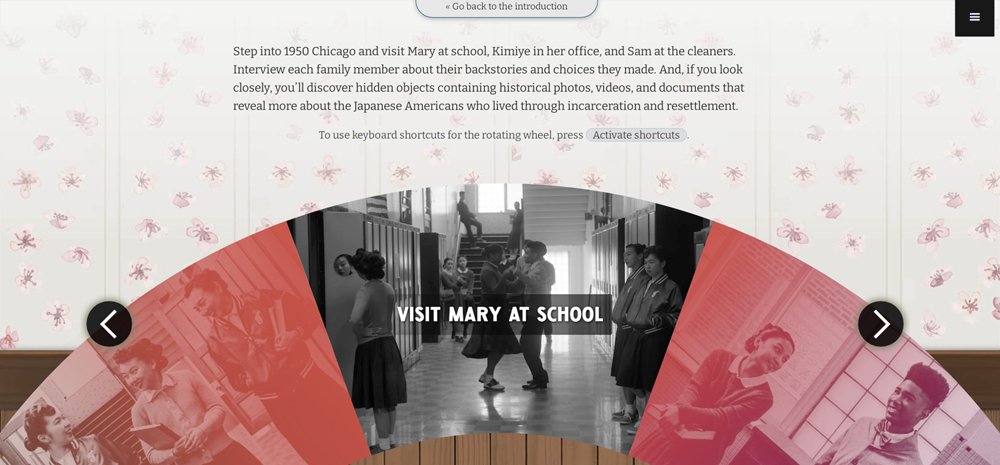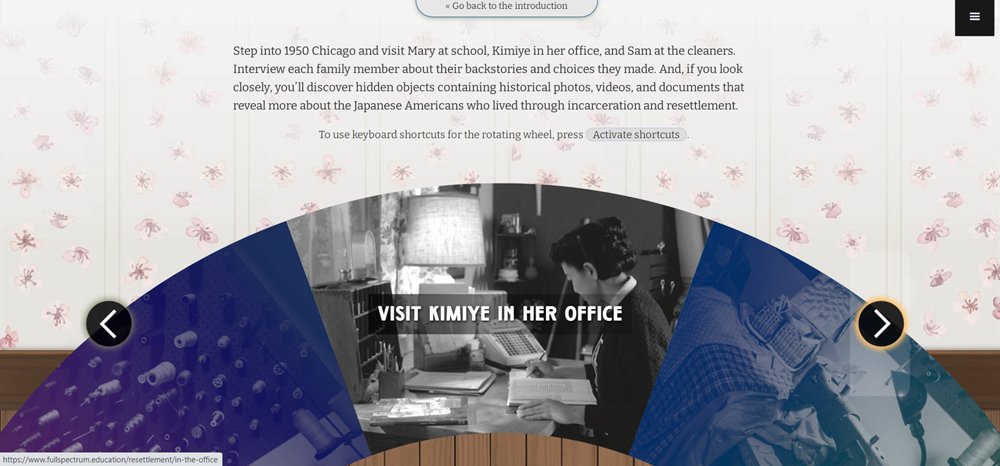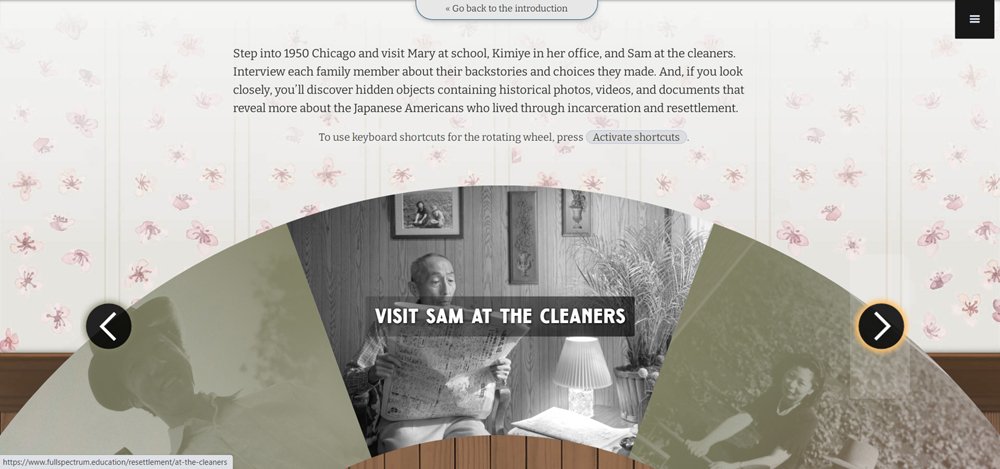Young Japanese Americans Bring Their Creative Power to Day of Remembrance
“Resettlement: Chicago Story” Premiered as Reminder of Fragile Civil Liberties
On February 19th, the same date that President Franklin D. Roosevelt signed Executive Order 9066 in 1942, the Japanese American community in Chicago held 2023 Day of Remembrance at the Chicago History Museum. It is the annual event to memorialize E. O. 9066 which led to the internment of 120,000 Japanese Americans during WWII, and the organizers of Day of Remembrance (DOR) aim to remind people of being vigilant for any threats to civil rights and liberties which are extremely fragile in times of crisis.
Hailee Nakai reads 1942 Civilian Exclusion Order
2023 DOR started with the posting of colors by the Chicago Nisei Post No. 1183, and Hailee Nakai, student of the Hoffman Estates High School, read the 1942 Civilian Exclusion Order, which facilitated the removal of “all persons of Japanese ancestry” from designated areas on the West Coast.
Jean Mishima, President of the Chicago Japanese American Historical Society, greeted and introduced main guests including Hiroshi Tajima, Consul General of Japan in Chicago.
This year’s main topic was world premiere of “Resettlement: Chicago Story,” which was produced by the Full Spectrum Features, a not-for-profit film production company led by Jason Matsumoto, Yonsei (fourth generation of Japanese American). The film and immersive learning website comprise what Full Spectrum Features calls a “cinematic digital history project.”
The film shows what resettlement looks like through Yamamoto family – Mary, Kimiye and Sam – as they adjust to life in postwar Chicago after being unjustly removed from home, confiscated their properties, incarcerated in a remote deserted area, denied to keep heritage and forced to resettle in Chicago.
The film “Resettlement: Chicago Story” and its companion, immersive learning website, were developed for teaching materials to respond to TEAACH Act (the Teaching Equitable Asian American Community History) which passed the Illinois General Assembly in July 2021 and took effect on Jan. 1, 2022.
It requires all public schools in Illinois, starting in 2022-2023 school year, to teach about the history and contribution of Asian Americans, including the wartime internment of Japanese Americans and their postwar redress movement. Illinois is the first state in the U.S. to mandate public schools to make it a part of their curriculum.
While the film visualizes what resettlement of Japanese Americans looks like, the immersive learning website is built upon both the characters and historical events of incarceration in interactive ways, so that viewers are able to get involved in the important social themes, the fragility of civil rights and liberties in times of crisis.
Jason Matsumoto Speaks about His JA Community
Jason Matsumoto, Full Spectrum Features
Jason Matsumoto, Co-founder and Co-Executive Director of the Full Spectrum Features, said, “Presenting this project to all of you is very personal. I grew up here as part of the Japanese American (JA) community. And I felt support connection and love from this community of people.” He continued that he knew about the people of JA organizations, who helped put the project together, and felt their buildings were safe and welcoming space to him. “And maybe most importantly, I see my own family’s history within this project, and it’s a history of forced removal, history of incarceration, and eventually a history of resettlement to Chicago. And what I hope for is that all of you, your family, friends and relatives, who went through this experience in the 1940s and continue to go through this experience until today, see yourselves in this project,” he said.
Matsumoto said that on the completion of the film and website, his team is going to work hard to distribute this educational material into classrooms, libraries, museums and conferences across the U.S., and his team’s effort will help people understand better what injustice the government had done to its civilians. So Matsumoto hopes viewers to care deeply about individual characters, which his team has created, to have human connection with them, so that they will get involved in more engaged investigation of the photos, the archival materials, the videos and oral histories.
And then Matsumoto asked DOR audience to introduce the resettlement story to their friends, teachers, local school districts and more.
According to Matsumoto, there were more than 130 people who had direct hands on contribution to the project including teachers, curriculum developers, scholars and activists. Actually this number of the people does not include the staff members from many organizations who have been an integral part of the project. He said it took literally a village size of people.
Matsumoto brought a real story of the Midwest Buddhist Temple in the 1940s to evoke the situation of JA resettlement era in Chicago. It was written by Reverend Gyodo Kono, founding minister of the temple.
Rev. Kono described one of the first large services that took place in July, 1944 at the Parkway Community Hall in the Bronzeville neighborhood today.
There were about 300 people of Japanese-speaking Issei (first generation) attending the service; therefore, the service was held in Japanese. In the middle of the service, FBI Agents and government officials interrupted the sermon and wanted to know what was going on and what messages had been delivered. Rev. Kono explained to the authorities that the service was to honor deceased relatives of the attendees.
And then the authorities told him that neighbors would be suspicious of such a large gathering of Japanese and requested that the attendees to leave the service in groups of four or five, five minutes apart. It would take hours and hours in that manner.
Matsumoto said that the period of time that the film takes place, resettling Japanese and JAs were under explicit instructions to assimilate to White, Christian, and Middle Class values. They were told to avoid creating ethnic enclaves and to stop speaking and using their own language. Many of the community members were under a constant surveillance and profiling by the U.S. government.
Matsumoto said, “For me personally this is a reminder not to lose sight of the significance of our ability to gather today. Our grandparents, our parents, friends, aunts, uncles, cousins and allies resisted. They did what humans naturally do. They build a strong and resilient community in spite of the pressures and demands by the highest authorities, and they gathered. So thank you for showing up today!”
Audience of Day of Remembrance on February 19, 2023 at the Chicago History Museum
According to Matsumoto, “Resettlement: Chicago Story” is the second project in a trilogy. The first one was “The Orange Story” which described relentless removal of JAs from their home, business and properties.
The third project will focus on the redress movement which was a social and political movement that resulted in U.S. Government’s formal apology and cash reparations for wrongful incarceration during WWII. Matsumoto said the trilogy was funded by a grant program sponsored by the Japanese American Confinement Sites.
Ashley Cheyemi McNeil, Ph.D.
Ashley Cheyemi McNeil, Ph.D., Project Management and Development, explained details of the website. When you visit the website, a vertical disk appears and you can torque it to see background of the Yamamotos. Arrows on the disk guide you to see what incarceration and resettlement are, and then the first scene of the Resettlement: Chicago Story appears. After seeing it, another disk comes up, and arrows again guide you to see Mary’s page, her mother Kimiye’s page and her grandfather Sam’s page. You can learn each character in depth through interactive manners.
Those three characters were created by the team of Full Spectrum Features based on numerous interviews conducted by the team. For example, young adults like Mary in the 1940s and 50s talked about how a young adult community was formed for resettled girls.
McNeil said some of those interviewees were among the audience of 2023 Day of Remembrance.
The website is: https://www.fullspectrum.education/projects/rcs
Moderated by McNeil, discussions about the film production and a Q&A session were held. Discussants were Reina Higashitani, Film Director and Assistant Professor of Film Studies, Arizona State University; and Helen Cho, Ph.D., Visiting Assistant Professor of Asian American Studies, Northwestern University.
This year, DOR organizers facilitated accessibility for everyone. Audio Description, Open Captions, CART (Real-time captions) and ASL Interpretation (sing language) were provided throughout the program.
2023 Day of Remembrance really showed creative power of young Japanese Americans to make immersive educational materials to remind everyone of fragile civil liberties in times of crisis.
----------------------------------------------------------------
Resettlement: Chicago Story
Film & Website Produced by: Full Spectrum Features NFP
Screenplay: Reina Higashitani and Eugene Sun Park
Film Producers: Jason Matsuoto, Yuki Sakamoto Solomon, Reina Higashitani
Project Management and Development: Ashley Cheyemi McNeil, Ph.D.
Film Directed by: Reina Higashitani
Executive Producer: Eugene Sun Park
Web and Impact producer: Katherine Nagasawa
Site Design and Production: auut studio
Day of Remembrance Sponsors:
Chicago Japanese American Council
Chicago Japanese American Historical Society
Japanese American Citizens League – Chicago Chapter
Japanese American Service Committee
Japanese Mutual Aid Society of Chicago
In collaboration with Chicago History Museum








